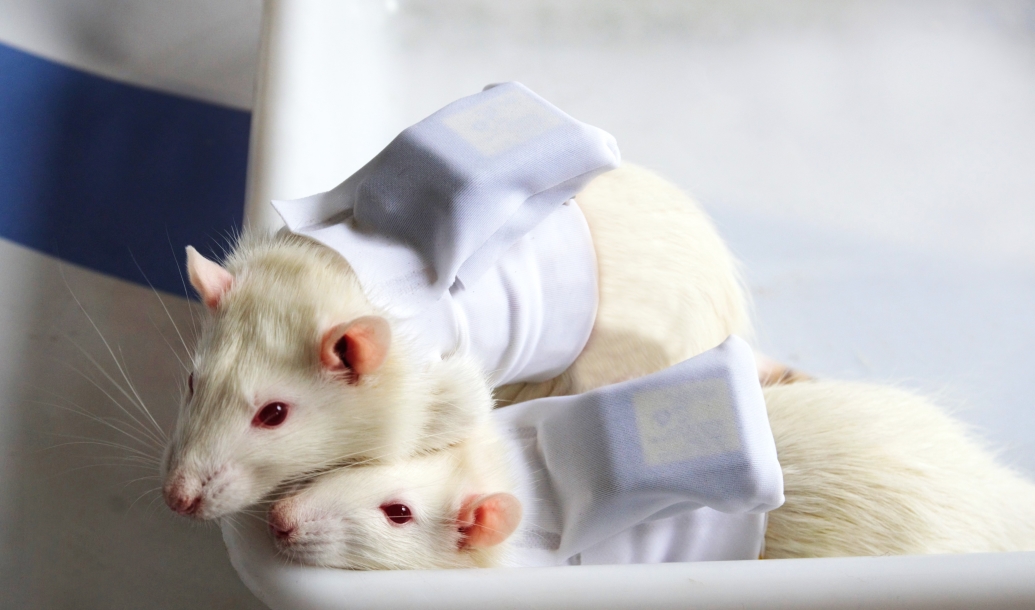Monitoring of vital functions
An effective approach to monitor health recovery or anticipate Human Endpoints after a surgery or a medical condition
Why it is important?
Most of vital function monitoring solutions primarily focus on intra-operative use, leading to a critical gap in physiological data once the animal recovers from surgery. Wearable telemetry closes this gap by enabling continuous, restraint-free, and non-invasive Home Cage Monitoring (HCM) of vital functions of the animals when they return from the operating room.
This approach enables researchers to monitor recovery of anesthesia on cardiac and respiratory function, alongside locomotor activity recovery, for extended durations from any location. This extended post-operative surveillance significantly reduces risk for the animal and facilitates early intervention by animal carers and veterinarians.
This approach allows for:
Monitoring of awakening following anesthesia: Monitoring of heart rate and respiratory rate as well as animal behavior (through activity intensity) after surgery with anesthesia for extended periods (12 to 24 hours).
Remote monitoring tracking: Remote access to vital signs of animals recovering from surgery, from the office or from home (VPN required).
Alerts : Configuration of physiological values to trigger alerts in case of alarming cardiorespiratory values.
Enhances animal welfare: Support animal care and early intervention.

Use Cases
Interested in real-time, non-invasive monitoring ?
Intraoperative Monitoring
DECRO external telemetry can be used during surgery to monitor heart rate and respiratory rate in real time. This allows researchers to assess the animal’s health status and adjust anesthesia as needed.
Supporting Humane Endpoints
At the request of ethics committees, DECRO telemetry can help anticipate humane endpoints in animals that have undergone severe procedures, by continuously tracking physiological signs that indicate distress or deterioration.
Continuous Monitoring in the Home Environment
DECRO telemetry enables 24 to 48 hours of continuous monitoring of vital functions in rats housed in their cages, as well as in mini-pigs or dogs in their home pens.
Animals can be accommodated in pairs during recordings, maintaining natural housing conditions while collecting high-quality physiological data.
Resources on Vital Functions Monitoring
Evaluating a non-invasive telemetry jacket as an alternative to the reference methods for cardio-respiratory safety pharmacological testing in rats
Khamlichi Fatima-Zahra1, Schauerte Heike1, Mayer Werner1 , Hezler Leonie-Theresa2, Martel Eric1 , Rast Georg1 , Pairet Nicolas 1 1 Boehringer Ingelheim Pharma, Department of Drug Discovery Sciences-General Pharmacology, Biberach/Riss, Germany2 Boehringer Ingelheim...
Adaptation of the DECRO telemetry system for integrated safety pharmacology endpoints in dogs
Raafat Fares1, Leandro Fontana Pires2,3, Delphine Bouard1 , Christine Laigot1, Sébastien Judé1, Charles Eynard2, Timothé Flenet2, Pascal Champeroux1 1: ERBC Chemin de Montifault, 18800 Baugy, France2: Univ. Grenoble Alpes, CNRS, UMR 5525, VetAgro Sup, Grenoble INP,...
Feasibility of non-invasive arterial blood pressure estimation using inductive plethysmography in anesthetized rats
Leandro Fontana Pires1,2, Agathe Cambier2, Stéphane Tanguy1, Charles Eynard2, Timothé Flenet2, François Boucher1, Pierre-Yves Gumery1 ¹ Univ. Grenoble Alpes, CNRS, UMR 5525, VetAgro Sup, Grenoble INP, TIMC, 38000 Grenoble, France;² R&D, ETISENSE SAS, 16 rue Jean...
Altered ECG parameters with loss of cardiac variability and prolonged QTc in a non-diabetic chronic kidney disease rat model
Matthieu Soulié1, Leandro Fontana Pires2, Agathe Cambier2, Ixchel Lima-Posada1, Frédéric Jaisser1 ¹ Inserm, UMRS 1138, centre de recherche des cordeliers, campus des cordeliers - Sorbonne université, Paris, France² Physiological monitoring instruments, ETISENSE SAS,...
Explore Other Applications
Phenotyping of disease models
Monitoring of ECG morphological changes, ventilation, and locomotor activity patterns changes to better characterize pathological phenotypes and understand underlying pathophysiological mechanisms.
Pharmacology and safety-toxicology
Assessment of the efficacy and toxicity of novel pharmacological compounds on cardiorespiratory and central nervous system (CNS) functions in rodent and non-rodent species using jacketed telemetry.
Education and Training
Learn physiology and pharmacology using jacketed telemetry on rehomed animals, or through a new digital approach with pre-recorded, on-demand datasets from cardiorespiratory studies.
Veterinary
Use wearable telemetry to monitor vital signs (heart and respiratory rates) or the development of medical conditions (e.g., cardiopathy), either at home or at the veterinary clinic.




